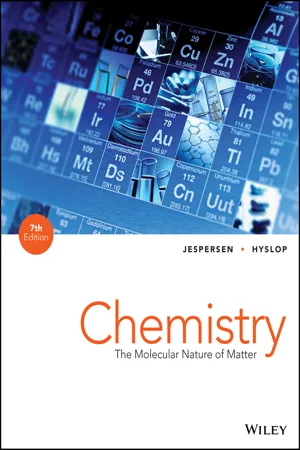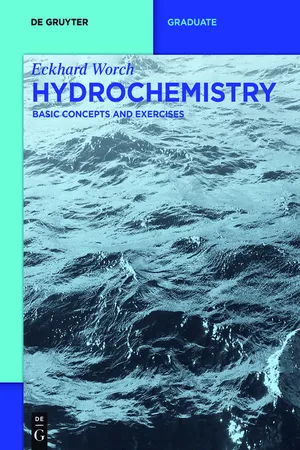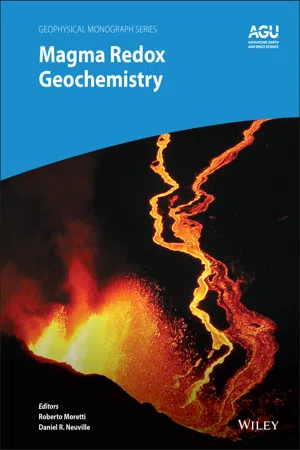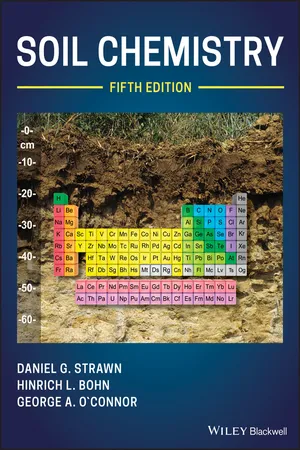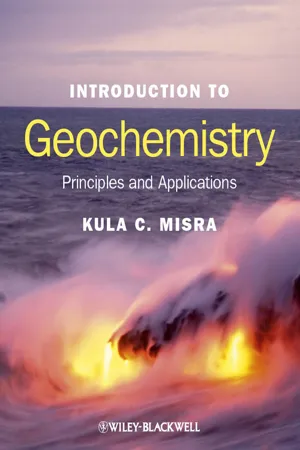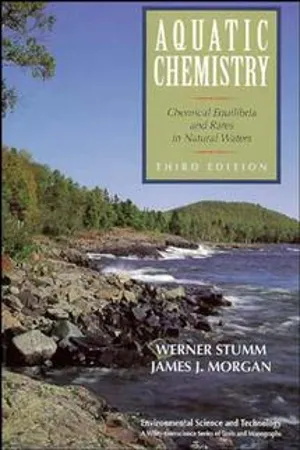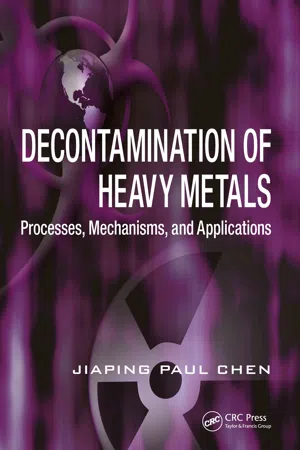Chemistry
Redox
Redox, short for reduction-oxidation, is a chemical reaction in which one substance transfers electrons to another. The substance that loses electrons is oxidized, while the one that gains electrons is reduced. Redox reactions are crucial in various chemical processes, including energy production, corrosion, and metabolism.
Written by Perlego with AI-assistance
Related key terms
Related key terms
1 of 4
Related key terms
1 of 3
8 Key excerpts on "Redox"
- eBook - ePub
Chemistry
The Molecular Nature of Matter
- Neil D. Jespersen, Alison Hyslop(Authors)
- 2018(Publication Date)
- Wiley(Publisher)
− .Na →oxidationNa ++e −reductionCl 2+ 2e −→ 2Cl −We say that sodium, Na , is oxidized and chlorine,Cl2, is reduced.- The term Redox was coined to emphasize that reduction and oxidation must always occur together in chemical reactions.
- Notice that when we write equations of this type, the electron appears as a “product” if the process is oxidation and as a “reactant” if the process is reduction.
Oxidation and reduction always occur together. No substance is ever oxidized unless something else is reduced, and the total number of electrons lost by one substance is always the same as the total number gained by the other. If this were not true, electrons would appear as a product or a reactant of the overall reaction, and this is never observed. In the reaction of sodium with chlorine, for example, the overall reaction is2 Na +Cl 2→ 2 NaClWhen two sodium atoms are oxidized, two electrons are lost, which is exactly the number of electrons gained when oneCl2molecule is reduced.- Electron loss must equal electron gain or else the law of conservation of mass would be violated.
For a Redox reaction to occur, one substance must accept electrons from the other. The substance that accepts the electrons is called the oxidizing agent ; it is the agent that allows the other substance to lose electrons and be oxidized. Similarly, the substance that supplies the electrons is called the reducing agent - eBook - ePub
Chemistry
With Inorganic Qualitative Analysis
- Therald Moeller(Author)
- 2012(Publication Date)
- Academic Press(Publisher)
19OXIDATION AND REDUCTION
Publisher Summary
This chapter explores the meaning of the terms “oxidation” and “reduction”. It presents the concept of electrochemistry to make clear the relationships among Redox reactions and what happens in electrochemical cells. The chapter describes the balancing of Redox equations. It presents the understanding and using of standard reduction potentials. The chapter discusses Nernst equation and explains the determination of equilibrium constants from standard reduction potentials. An oxidation-reduction reaction can be thought of as the sum of two half reactions. Each ion-electron equation includes both the oxidized form and the reduced form of the same species. Therefore, a complete Redox equation contains at least two oxidants, the electron acceptors and two reductants, the electron donors.In this chapter the meaning of the terms “oxidation” and “reduction” is explored, and just enough electrochemistry is presented to make clear the relationships between Redox reactions and what happens in electrochemical cells. (The electrochemical cells themselves are discussed in Chapter 24 .) The main additional topics covered are balancing Redox equations, understanding and using standard reduction potentials, and the Nernst equation and the determination of equilibrium constants from standard reduction potentials.T“Oxidation” and “reduction” are other words that have undergone changes in meaning. Earlierhe English language, like most others, is constantly changing. Words go out of fashion and disappear, new words are coined as new ideas and materials develop, and, most importantly, well-established words gradually assume new meanings. Consider, for example, the word “tremendous.” It was adapted into our language from a Latin word which meant “to cause to tremble”; that is, “awesome,” “dreadful,” “fearful.” Because we imagine awful and dreadful things to be very large, the word has come to mean “large.” - eBook - ePub
- Eckhard Worch(Author)
- 2015(Publication Date)
- De Gruyter(Publisher)
10 Redox equilibria10.1 Introduction
Redox reactions belong, besides acid/base reactions, to the most important processes in aquatic systems. The term Redox is a combination of the words reduction and oxidation. Oxidation and reduction are reverse reactions and the term Redox indicates that they are always coupled. An oxidation is defined as a loss of electrons, whereas reduction means gain of electrons. A number of water constituents are able to take part in Redox reactions. This means that they can be reduced or oxidized or, in other words, they can change their oxidation state. The change of the oxidation state is typically connected with a change in the properties and in many cases also with a change in the composition of the species. The oxidized and the related reduced species form a Redox couple (also referred to as Redox pair). Examples of Redox couples frequently occurring in aquatic systems are O2 /H2 O, , , , MnO2 /Mn2+ , Fe(OH)3 /Fe2+ , , CO2 /CH4 and CO2 /Cx Hy Oz . The given examples demonstrate that a number of major and minor water constituents are part of Redox couples, which underlines the relevance of Redox reactions in aquatic systems. As we can further see, some species are constituents of different Redox couples. This is possible when the considered element occurs in more than just two different oxidation states, such as nitrogen, which can occur in aquatic systems as , , N2 or .To formulate Redox reaction equations and to carry out equilibrium calculations, we need a specific parameter that characterizes the oxidation state of a considered atom in a given species. This parameter is known as the oxidation number (or oxidation state). It can be estimated in different ways as will be shown in the next section. For a considered Redox couple, the lower value of the oxidation number characterizes the reduced form, whereas the higher value characterizes the oxidized form. If necessary, the oxidation number is written above the symbol of the atom, for instance +5 –3 and NH3 - eBook - ePub
- Roberto Moretti, Daniel R. Neuville(Authors)
- 2021(Publication Date)
- American Geophysical Union(Publisher)
Transition metals and main group elements (e.g., N, halogens, O, S, C) have multiple oxidation states and important Redox chemistry, which affect element distribution within the geochemical shells on Earth but also through the boundaries between such shells (e.g., Moretti et al., 2020a). For instance, it is the Redox state of metals and ligands that complex them, which then determines (i) their “unlocking” from pristine reservoirs (e.g. minerals in which they occur at trace level); (ii) their mobility on Earth through carriers such as magma, water, or vapor; and eventually (iii) their accumulation and precipitations in new phases making up ore deposits. Redox reactions involve a coupled transfer of electrons, so for any oxidation (loss of electrons) a reciprocal reduction (gain of electrons) occurs. Moreover, Redox reactions naturally occurring on Earth involve a net chemical change that can be described not only via the exchange of electrons between ions or their complexes, but also of oxygen and/or hydrogen atoms and compounds that these can form (e.g., Cicconi et al., 2020a and references therein). Here are some examples: (1.1) (1.2) (1.3) (1.4) (1.5) In which the subscripts s, m, aq, and g refer to solid, melt, aqueous, and gas (including supercritical fluids) phases, respectively. In the five examples above, O 2(g), H 2 O (g), Fe 3+ (aq), O 2(g) and SO 2(g) are oxidizing agents, whereas Fe (s), FeO (l), H 2(g), Fe 2+ (aq) are the reducing agents. The word oxidation was introduced by Antoine Lavoisier (1777) and indicates the chemical mechanisms in which oxygen is consumed and added to a compound. The parallel mechanism in which some other compounds loose oxygen was called reduction. The oxidation number of reaction components in Reactions 1.1 to 1.5 shows that some elements have a greater affinity for electrons than others and that oxygen tends to appear with oxidation number –II in its compounds (including the O 2– species in its ionic compounds) - eBook - ePub
- Daniel G. Strawn, Hinrich L. Bohn, George A. O'Connor(Authors)
- 2019(Publication Date)
- Wiley-Blackwell(Publisher)
5 Redox REACTIONS IN SOILS5.1 Introduction
In reduction and oxidation reactions, atoms exchange electrons causing changes in oxidation states and chemical species, and thus dramatically change the behavior of chemicals in soils. Redox reactions can be abiotic or biotically driven. In most natural systems, biological reactions have the greatest influence on Redox processes. Redox reactions are fundamental to biogeochemical processes in soils because they influence pedogenesis and change mobility and bioavailability of nutrients and contaminants.Table 5.1shows some of the most common elements involved in Redox processes in soils, and their oxidation states.Oxidation is the loss or donation of electrons by an element. Reduction is the gain or acceptance of electrons. For example, the reduction reaction of Fe3+ to Fe2+ , which is an Fe3+ –Fe2+ couple, is(5.1)where e– is a free electron. The reaction inEq. 5.1is a half‐reaction because it does not show where the electron is coming from, and thus describes only half of a complete reaction. Although half‐reactions imply that free electrons exist, the free electron is a theoretical concept that does not occur in nature; the electron is always associated with an atom and directly transferred between ions or molecules. Thus, reduction of one substance requires oxidation of another.An example of an oxidation half‐reaction that provides electrons is oxidation of sulfide to elemental sulfur (S2− –S0 couple):(5.2)This half‐reaction produces two electrons that must be donated to another element in a reducing half‐reaction, which is not shown.Reactions inEq. 5.1andEq. 5.2 - eBook - ePub
Introduction to Geochemistry
Principles and Applications
- Kula C. Misra(Author)
- 2012(Publication Date)
- Wiley-Blackwell(Publisher)
4 ). Oxidation–reduction reactions are important in all geologic processes: magmatic, diagenetic, metamorphic, chemical weathering (e.g., the familiar reddish-yellow rust on iron garden tools), and formation of mineral deposits. In the realm of industrial applications, oxidation–reduction reactions are the basis of electrochemistry (chemical changes produced by an electric current and the production of electricity by chemical reactions), recovery of metals from many types of ores and wastes, and treatment of municipal sewage and industrial effluents.8.1 Definitions
Reactions resulting from addition of oxygen (e.g., 2Ni + O2 = 2NiO) evidently represent oxidation. However, a reaction does not have to involve oxygen to qualify as an oxidation or a reduction reaction.Oxidation is defined as a reaction involving the loss of one or more electrons and reduction as a reaction involving the gain of one or more electrons.Thus, oxidation involves an increase in oxidation state , and reduction a decrease in oxidation state. For the purpose of illustration, let us consider the oxidation of magnetite (Fe2 + O. ) to hematite in the presence of water. Following the convention used by Garrels and Christ (1965, p. 132) and subsequently by many other authors (e.g., Krauskopf and Bird, 1995; Faure, 1998; McSween et al - eBook - ePub
Aquatic Chemistry
Chemical Equilibria and Rates in Natural Waters
- Werner Stumm, James J. Morgan(Authors)
- 2012(Publication Date)
- Wiley(Publisher)
Before we generalize, we should discuss the question: Can we estimate Redox reactivity with the help of thermodynamics? A simple affirmative answer would be wrong. But it is often useful to consider thermodynamics, in order to gain some insight into reaction mechanisms and kinetics. Most Redox reactions are, from a stoichiometric point of view, processes where more than one electron is transferred. But most of these processes occur in a series of one-electron steps. For example, oxidative or reductive transformations of an organic compound require two electrons to yield a stable product. In the majority of abiotic Redox reactions, the two electrons are transferred in sequential steps. With the transfer of the first electron, a radical species is formed, which is, in general, more reactive than the parent compound. Thus the rate-determining step very often will be the transfer of the first electron (Eberson, 1987).In an example that we have already discussed (Section 11.4), the oxidation of Fe(II) by oxygen is initiated by a one-electron transfer to O2 from a Fe(II) species; thus the radical O is formed:(39)As we have seen, this reaction step is determining for the rate of the overall reaction(40)To investigate or explore LFERs between thermodynamic and kinetic data of Redox processes, one should (1) try to interpret the process in terms of elementary (one-electron) reaction steps, and (2) try to identify the rate-determining step.One can then attempt to relate the free energy of the reaction (or the equilibrium constant or the Redox potential) of the one-electron step to the rate of the reaction. Extensive tabulations of one-electron Redox potentials have recently become available (e.g., Wardman, 1989). Often it is possible to relate rate constants to free energy parameters (ΔGo , K, pεo ) in a series of related Redox reactions (e.g., oxidation of ions of transition elements with O2 , H2 O2 , MnO2 , Fe2 O3 - eBook - ePub
Decontamination of Heavy Metals
Processes, Mechanisms, and Applications
- Jiaping Paul Chen(Author)
- 2012(Publication Date)
- CRC Press(Publisher)
5Reduction-Oxidation Processes
5.1IntroductionReduction-oxidation (Redox) processes may be defined as the processes that result from Redox reactions, and can be used for treatment of metallic waste streams or understanding of natural/engineered processes that can change the nature of heavy metals.1 , 2 , 3 , 4 , 5 , 6 , 7 , 8 , 9 , 10 , 11 and 12Depending on the objective, there is always one half-reaction (reduction or oxidation) playing a major role in the process. Table 5.1 shows the important half-reactions.13When reduction is used, heavy metal ions (mono-, di-, or trivalent, M+ , M2+ , or M3+ ) can be converted to metal ions with lower valency or zero-valent metal (M0 ). For example, hexavalent chromium (Cr(VI)) can be reduced to less toxic trivalent chromium in the biosorption process, and monovalent silver ion can be reduced to zero-valent silver by using hydrazine or electroplating.When oxidation is used, heavy metal (with valency of zero or higher) can be oxidized. For example, zero-valent iron as a sacrificial metal can be oxidized, which produces coagulant for the heavy metal removal, a process called electrocoagulation (EC), which is addressed in Chapter 6 . Trivalent arsenic can be oxidized to pentavalent arsenic, which is less toxic and more easily removed from groundwater.Redox reactions can be further classified into two groups based on the nature of the oxidizing agent (oxidant) or reducing agent (reductant or reducer): chemically induced Redox reactions and electrochemically induced Redox reactions. The first type reaction occurs when a chemical is added, which leads to Redox reactions. The chemical is often in the form of a liquid such as hydrazine. The second type reaction occurs when direct current is applied, which is discussed in Chapter 6 .Redox reactions play important roles in natural and engineered processes for metal waste management. It is one of the major technologies for metal wastewater treatment. It is particularly suitable for decontamination of metallic waste stream when the concentration is above 1 mM. Redox distinguishes itself from other technologies as it can convert metal ions to the zero-valent form, which can be further processed and used in industries (Table 5.1
Index pages curate the most relevant extracts from our library of academic textbooks. They’ve been created using an in-house natural language model (NLM), each adding context and meaning to key research topics.
Explore more topic indexes
Explore more topic indexes
1 of 6
Explore more topic indexes
1 of 4
